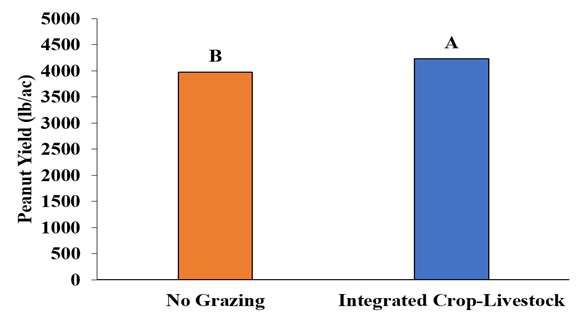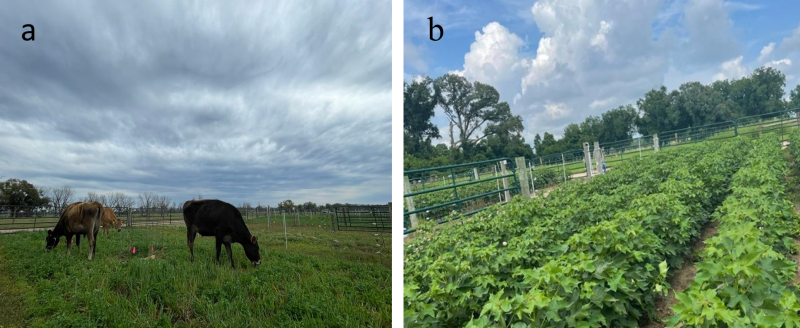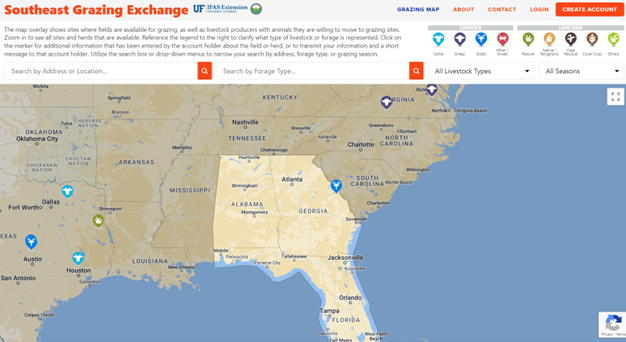Igor Bretas, and Jose Dubeux, UF/IFAS – North Florida Research and Education Center
Introduction
The Southeast U.S. region includes 10 States and covers around 1.3 million km2 (USDA, 2017). Beef production systems in these states are predominantly pasture-based cow-calf operations. Grasslands cover around 15.8 million ha in the Southeastern U.S and are dedicated mainly to beef production systems (USDA, 2012). Additionally, row crops, mainly cotton and peanut, cover a large portion of the landscape during the warm season in Florida, Georgia, and Alabama. However, after harvesting in September-October, most row-crop land lays fallow, without cover crop. Integrated crop livestock systems (ICLS) and grazing cool-season cover crops are improved management practices recommended to reduce soil erosion, weed encroachment, and nitrate leaching during the fallow season. Besides the benefits of soil cover, grazing animals recycle nutrients back to the crop field, increasing soil fertility, reducing the input of fertilizers, and increasing crop production (Figure 1).

Figure 1 – Contrast effect of No Grazing vs. Integrated Crop-Livestock on peanut yield (P < 0.10). Means followed by a different letter statistically different. No Grazing = No Cover, Cover + 30 lb. N/acre, Cover + 80 lb. N/acre; Integrated Crop-Livestock = ICL-Over grazing, ICL-Moderate grazing, ICL-Under grazing. (Dubeux et al. 2022).
–
The integration of livestock and crop production can generate income as a win-win strategy. Thus, livestock producers are encouraged to integrate crop and livestock, as well as plant cool-season cover crop during the fallow season to improve the land use efficiency and profitability (Figure 2).

Figure 2 – Animals grazing cover crop during cool season (a) and cotton planted in the following summer (b) in the same field in an integrated crop and livestock system in North Florida. Photo credit: Luana Queiroz.
–
Challenges for adoption
Livestock producers and landowners must overcome many obstacles to implementing such systems. Some landowners are not interested or able to handle and invest in animals and infrastructure (i.e., fences, feed bunker, water trough, etc.), making the land lease as an opportunity to generate income and improve the farm facilities. In addition, crop producers sometimes are not financially rewarded due to the volatility of grain prices or adverse weather conditions that harm the productivity. Integrating livestock in cropping systems during the fallow period could be an alternative to overcome seasonal constraints of crop production. Besides, grazing cover crops during the cool-season ensures land use during the fallow period, bringing soil benefits for the following crop. Livestock producers also can benefit from the high quality of cool-season forages while summer annual crops are unavailable or whenever perennial pastures are dormant. Likewise, landowners can take advantage of underused pasture areas for the livestock production and get benefits from the nutrient cycling and soil cover. In these situations, the connection between livestock producers, crop producers and landowners could be a cooperation strategy to overcome the production challenges and boost profitability.
–
Southeast Grazing Exchange website
Promoting the partnership between row crop and livestock producers seems to be the best strategy to improve the adoption of ICLS, and consequently, land use efficiency and profitability. In order to achieve this purpose, livestock producers and landowners from other states have been using the Match.Graze (matchgraze.com) platform in recent years. This platform helps producers to find opportunities to lease land or contract with livestock producers to graze their cover crops in a simple and friendly interface. Match.Graze allows for cooperation among livestock producers, row crop farmers, and landowners. Based on the previous success of the platform and benefits reported by farmers from other states, researchers from the North Florida Research and Education Center (NFREC), University of Florida, mobilized an effort in the last months to launch a similar platform to assist producers and landowners from the Southeastern U.S. Currently, producers can access the new platform through the website Southeast Grazing Exchange (southeastgrazingexchange.com). The website displays a regional map, which allows producers to create pins for their farms and find data voluntarily submitted by other farmers, such as acreage, soil type, animal category, forage species, location and contact information to assist producers interested in connecting each other to overcome specific constraints of their production systems (Figure 3). The platform will facilitate the connection between producers interested in partnering together to have cover crop and grazing during the fallow period.
–
Take Home Message
Integrating crop and livestock systems seems to be the best strategy to overcome the fallow season, improving nutrient cycling, soil fertility, and leading to greater crop production with reduced costs. Livestock systems might also benefit because of higher forage quality and potential to achieve greater gains when grazing cool-season cover crops. Finally, nitrate leaching is reduced when cattle graze cover crops, compared to fallow. The Southeast Grazing Exchange website is a new tool to connect livestock producers and landowners throughout the Southeastern States and make the cooperation accessible. Producers and landowners are strongly encouraged to access the new platform and provide details of the agricultural resources available to help each other to improve the efficiency of production.
References:_
- Dubeux, J.C.B., Jr., E.R.S. Santos, L.D Queiroz, I.L. Bretas. Grazing cover crops increases peanut yield and mitigates nitrate leaching. Available at: Grazing Cover Crops Increases Peanut Yield and Mitigates Nitrate Leaching
– - USDA-NASS. 2017 Census of Agriculture.
_ - USDA-NASS. 2012 Census of agriculture.
- 2025 UF/IFAS Forage Legume Conference – May 1 - March 28, 2025
- How are My Cool-season Forages Recovering from the Snowfall and Low Temperatures? - January 31, 2025
- Integrated Crop-Livestock Systems Improve Soil Health - July 26, 2024

